Introduction
Who wants to be writing and listening to your coworker in the next room talking to someone? Distractions are everywhere and sound definitely ranks high for most people, whether they are working or trying to enjoy a book or another conversation. Soundproof walls are important in many types of areas such as Commercial Spaces, residential, and industrial just to name a few, or anywhere else unwanted sounds are entering a space. In this blog, we will discuss building practices to block unwanted sounds from entering or exiting a wall.
What are Soundproof Walls?
Soundproof walls are simply walls that can stop the Sound Transfer from one side of the wall to the other; the more sound, the more built-up the wall; ideally the other side will not be able to hear, as it will drop below the noise floor of the room.
What is a noise floor? For our purposes, it is the lowest total sound level (dB) inside a given space. Think of an HVAC Fan — it is constantly on — because of that it makes sound at a constant dB level, and noises under this dB will become difficult to hear or disappear altogether. To properly gauge what type of wall or building practice to employ, you would first want to understand the potential noise dB level and the desired noise floor on the other side. Once you have those numbers you can simply find their difference by taking one away from another, (unwanted noise – noise floor = the amount of sound we are trying to block). Now that we know the delta, we can begin building the wall; this could be new construction or retrofit—it does not matter, the principle stands.
Why are Soundproof Walls Important?
There are many reasons that Soundproof walls are important, such as privacy, efficiency, or luxury:
- Possible loss of efficiency/sales in the workplace.
- Private data shared in HR/management offices, therapist offices, and government offices.
- Luxury homes/apartments that are selling high-end and quiet lifestyles.
- Customer satisfaction while making transactions in business offices.
In most instances noise is not meant to be heard, and walls should be properly built or retrofitted to either contain or block out the noise.
Examples of Soundproof Walls
Let’s say that we have noise at 80 dB and a noise floor of 50 dB on the other side—a delta of 30 dB. This example is relatively easy (assuming standard human speech), starting with a standard framing (2’x4’s, 16″ On Center (O.C.)), we should be able to accomplish this 30dB reduction with one layer of 5/8″ drywall on each side with batt insulation between. Now, say you have 90 dB on one side and a noise floor on the other side of 40 dB, now the Delta is 50 dB. This could be treated in many ways:
- We could use Green Glue Damping Compound in between an additional layer of 5/8″ drywall on one side or both sides of the wall in the earlier example
- Add AudioSeal® Mass Loaded Vinyl (MLV) Soundproofing Barrier, then finish off with 5/8″ drywall
- Add RSIC Clips and hat track, then another layer of 5/8″ drywall to finish up the system
- All the above. Depending on the noise level and its difference from the quiet space, you may need to utilize more than one approach.

All soundproof walls need to be treated the same across the whole wall in question, this includes electrical outlets, the seams/perimeter of butt joints, windows, and doors. Products may include: firestop putty pads, sealant, or PrivacyShield window inserts.
In case you need it, we have a Glossary of terms to help catch up on some of the terminology.
Tips and Reminders for Soundproof Walls
When up against a sound transfer problem through a wall, keep in mind to:
- Understand the problem, how loud is one side, and what is the noise floor of the other?
- What is the difference in dB that the wall needs to block?
- What stage or limitations do you or the building have (i.e. is the wall already in place)?
- Once you have the above, go through available options and work backward to solve your noise issue.

Examples of sound barriers in ceilings, floors, and walls
Summary
To summarize, understand your noise problem, create a solution using key products and building practices, and enjoy the quiet. To dive in deep on another blog regarding soundproofing, check out Soundproofing a wall!
To learn more about how Acoustical Solutions can solve your noise control problems, use our contact form, call one of our Acoustical Sales Consultants at (800) 782-5742, or visit us on the web at acousticalsolutions.com.